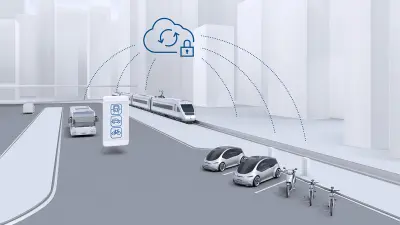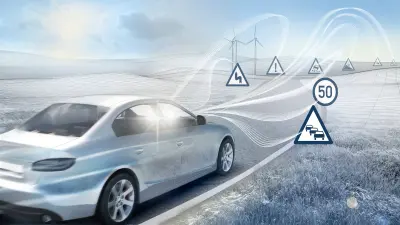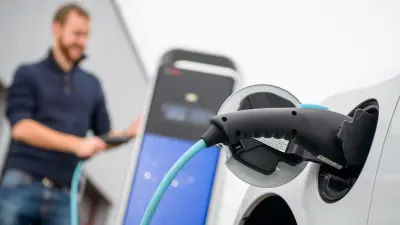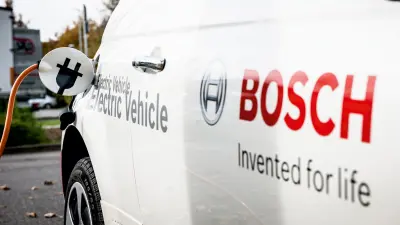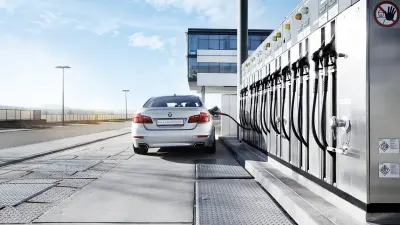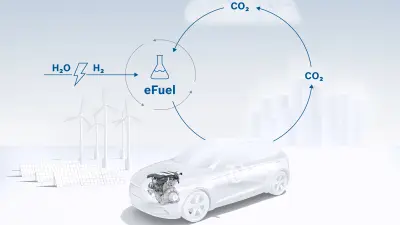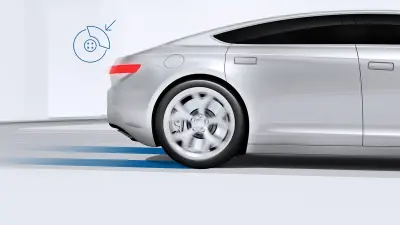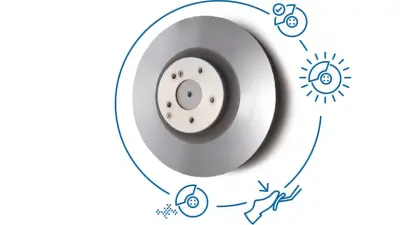Sustainable mobility
One challenge – four solutions
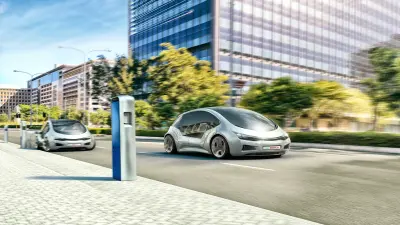
The traffic of tomorrow will be emission-free, flexible, and resource-saving. To reach the goals set out in the Paris climate agreement, smart and sustainable mobility concepts are needed that connect eco-friendly technologies with digital services. Here, we describe four new approaches to sustainable transportation.
1. Connectivity
the cloud enhances sustainable mobility
In major cities, traffic volumes will triple by 2050. This is why flexible, efficient, and sustainable forms of transportation are needed in urban centers. Connectivity is the solution to this challenge. Among other things, intelligent systems can guide drivers to available parking spaces and warn them of traffic congestion. They can also make it easier to switch between different means of transport. By 2025, 470 million smart vehicles will be on the road worldwide. Bosch is driving this transition forward with connected applications. About 1.5 million vehicles are already equipped with Bosch IoT software. Connected services for e-mobility are an important area of development. For example, when estimating a vehicle’s range, the cloud takes driving style into account as well as data gathered in the car’s surroundings. In addition to this, the system plans charging breaks along the route ahead of time and automatically pays the amount due. Bosch is planning to develop even more forward-looking mobility services in the future. To this end, the company founded its new Connected Mobility Solutions division at the beginning of 2018.
470 million
smart vehicles will be on the road worldwide by 2025.
2. Electrifying
sustainable e-mobility in the fast lane
About 3.2 million electric cars were on the world’s roads in 2017. In 2025, close to 20 million electric and hybrid cars will leave the assembly line. To accelerate the breakthrough of e-mobility and thus promote sustainable mobility, advances must be made in all relevant technologies. This includes electric drive solutions, lightweight components, and comprehensive charging services. The eAxle, which Bosch developed in 2017, is an example for this approach: it combines an electric motor, power electronics, and a transmission, thereby saving space while increasing efficiency. This electric axle can be used in hybrid and electric vehicles, small passenger cars, SUVs, light commercial vehicles, and e-scooters. Series production is scheduled for 2019. For short distances in city traffic, Bosch has also developed a scalable 48-volt drive system for small vehicles such as the e.Go Life city car. Apart from battery-based e-mobility, fuel cell technology will also play an increasingly important role in the future. Bosch is already working on development projects for long-haul trucks with hydrogen drives, and is thus gradually expanding its portfolio in order to reduce the environmental footprint of transport.
3. Synthetic fuels
turning greenhouse gases into sustainable fuel
To keep global warming below two degrees Celsius, global CO₂ emissions in transport must be reduced by about 50 percent within the next four decades, and by as much as 85 percent in the industrialized nations. While electrification – whether with batteries or fuel cells – is decisive to reaching this goal, alternative drives will not suffice. Even if all cars are one day electric, airplanes, ships, and trucks will continue to depend on liquid fuels due to the large distances they travel. However, the internal combustion engine may soon also be carbon neutral as a result of e-fuels, synthetic fuels that are produced using renewable sources of energy and carbon dioxide. An eco-friendly, carbon neutral internal combustion engine is possible if the required carbon is collected from the atmosphere, or from sources where CO₂ emissions cannot be avoided. When combined with conventional fuels, e-fuels can make a direct contribution to reducing the emissions of existing vehicles.
4. Innovative brake discs
reducing particulate matter for more sustainability
Most particulate emissions in traffic are not caused by fuel combustion, but by the wear and tear of disc brakes and tires, which accounts for about a third of the pollutants emitted in urban centers and therefore represents a significant environmental burden. Reducing particulate matter would thus make a major contribution to sustainable mobility. This is what Bosch aims to achieve with its innovative brake disc. Thanks to a special tungsten carbide coating, the iDisc generates up to 90 percent less brake dust than conventional models. It is also much more resistant to wear. Depending on the coating thickness, the iDisc is twice as durable as a normal brake disc. This especially benefits electric vehicles. Thanks to regenerative braking, their brakes are not under as much strain, but rust film tends to develop on the friction rings. This does not occur with the corrosion-resistant iDisc, which makes braking maneuvers safer.
Outlook
E-mobility will make a major contribution to the sustainable mobility of tomorrow. Given the urgency of climate change, however, the transition calls for a comprehensive approach that combines innovative technology and digital services. To reach the climate goals set out in the Paris agreement, the internal combustion engine will have to run increasingly on carbon-neutral fuels, and the focus will need to shift to alternatives to owning a car.
